The Arctic tundra and Antarctica rank as some of the coldest regions of the world. In winter, temperatures in these frigid landscapes can drop below -100 degrees Fahrenheit. It’s difficult to imagine anything living outdoors in these bone-chilling temperatures. Still, numerous creatures have developed special adaptations to help them survive extreme temperatures and limited food sources in the world’s coldest places. Let’s discover 10 animals that live and thrive in the cold.
1. Polar Bear
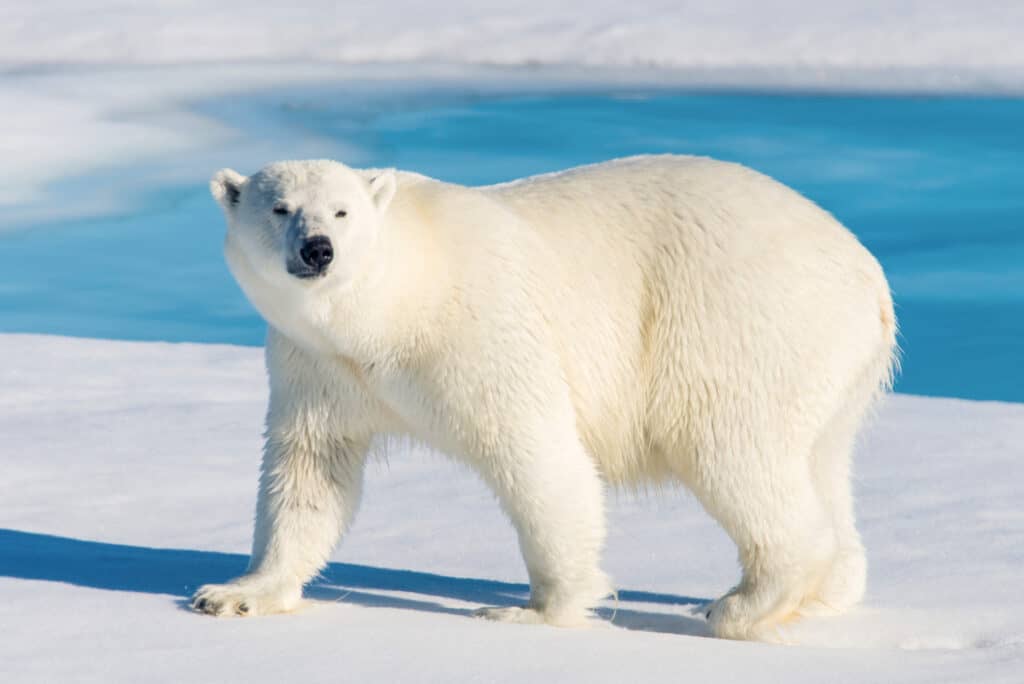
Polar bears’ enormous size – and substantial amounts of fat – help to insulate them from the cold.
©iStock.com/Alexey_Seafarer
The first entry on our list may also be the most recognizable. Polar bears (Ursus maritimus) belong to the bear family Ursidae. These giant carnivores live in the Arctic Circle, along the coast of Greenland, Canada, Russia, and Norway. Despite the fact they are land-dwelling animals, polar bears are technically classified as marine mammals because they can spend months at a time out at sea.
Polar bears rely on their thick blubber and two layers of fur to keep them warm. Adult males can weigh anywhere from 770 to 1,500 pounds and measure 8 to 10 feet long. Their enormous size – and substantial amounts of fat – help to insulate them from the cold. Their shaggy coat of white hair also acts as a form of camouflage, which helps them sneak up on their preferred prey, seals. This helps ensure they eat regularly and maintain a thick layer of fat. Thanks to these adaptations, polar bears can survive temperatures as low as -50 degrees Fahrenheit.
Currently, the IUCN classifies polar bears as a Vulnerable species. Climate change has caused significant habitat loss and affected polar bears’ ability to find food and shelter. While numerous efforts are underway to protect these magnificent animals, much more needs to be done to ensure their survival.
2. Arctic Fox

This baby Arctic fox has a bushy tail and large ears to help it regulate body temperature and maintain balance on slippery ice and snow.
©bhavdip12/Shutterstock.com
Also known as the white fox or snow fox, the Arctic fox (Vulpes lagopus) belongs to the canine family Canidae. These small, hardy foxes live throughout Arctic tundras in Europe, Asia, and North America.
An adult Arctic fox is quite small, with most specimens weighing between five and 10 pounds. Despite their tiny size, they have evolved several traits to help them survive terribly cold environments. Arctic foxes possess dense, multilayer fur. In winter, their fur looks white or blue, which helps them blend into their surroundings. Foxes with white fur undergo a color change in summer to gray or brown. Meanwhile, blue foxes typically remain bluish-gray year-round. Their bushy tails and large ears help them regulate their body temperature and maintain balance on slippery ice and snow. Additionally, unlike other canines, Arctic foxes grow fur on their paw pads.
Arctic foxes feed on a variety of prey, including small rodents, fish, birds, eggs, and carrion. They survive harsh winters by storing food for later consumption or by gaining extra weight. Although most Arctic foxes do not live past one year of age, it’s possible for them to live up to 11 years.
3. Walrus

A super thick blubber layer measures 6 inches thick and insulates the walrus from cold Arctic temperatures.
©Captain Budd Christman, NOAA Corps, Public domain, via Wikimedia Commons – License
Walruses (Odobenus rosmarus) are large pinnipeds in the family Odobenidae. Closely related to seals, these giant marine mammals live in Arctic and sub-Arctic waters in the Northern Hemisphere. When not searching for food in the water, walruses spend most of their time lounging on sea ice.
While most adult males weigh between 1,800 and 3,700 pounds, they can weigh up to 4,400 pounds! Walrus skin measures up to 4 inches thick in some places and can comprise approximately 20% of its total body weight. Meanwhile, beneath this skin lies a super thick layer of blubber. This blubber layer can measure 6 inches thick and insulates the walrus from cold Arctic temperatures. Aside from its massive size, a walrus’s most noticeable feature is its oversized teeth or tusks. Walruses use their 3-foot-long tusks to fight one another and also for dominance displays.
For hundreds of years, people hunted walruses for their meat, blubber, and tusks. Although most governments now regulate walrus hunting, walruses continue to face threats, particularly from climate change. Retreating ice levels puts stress on walrus populations and makes it harder for them to find food. In just the past few years, the IUCN updated its classification of walrus from Least Concern to Vulnerable.
4. Snowy Owl

Snowy owls rank as the largest bird of prey in the Arctic and one of the largest owl species worldwide.
©iStock.com/Pasforward
The snowy owl (Bubo scandiacus) also goes by polar owl, white owl, and Arctic owl. A member of the true owl family Strigidae, you can find this large white owl throughout the Arctic tundra. Snowy owls typically breed at northerly latitudes in Alaska, Canada, Russia, and northern Europe and then migrate south during winter due to a lack of available prey.
Snowy owls rank as the largest bird of prey in the Arctic and one of the largest owl species worldwide. Males can grow 20.7 to 25.2 inches long and feature a wingspan between 3 feet, 10 inches, and 5 feet, 5 inches. As their name implies, snowy owls sport predominantly white feathers. In fact, their feathers are even whiter than the fur of other Arctic predators like polar bears and Arctic foxes. Their white feathers help them avoid detection by prey animals, such as lemmings, voles, and other small mammals. Their thick plumage also helps them withstand temperatures of -60 degrees Fahrenheit without shivering.
The health of the snowy owl population worldwide relies heavily on the health of the lemming population. Since lemmings are the snowy owl’s primary food source, when lemming populations collapse, so too do snowy owl populations. Presently, experts estimate that between 14,000 and 28,000 breeding pairs remain in the world. As such, the IUCN lists the snowy owl as a Vulnerable species.
5. Arctic Hare
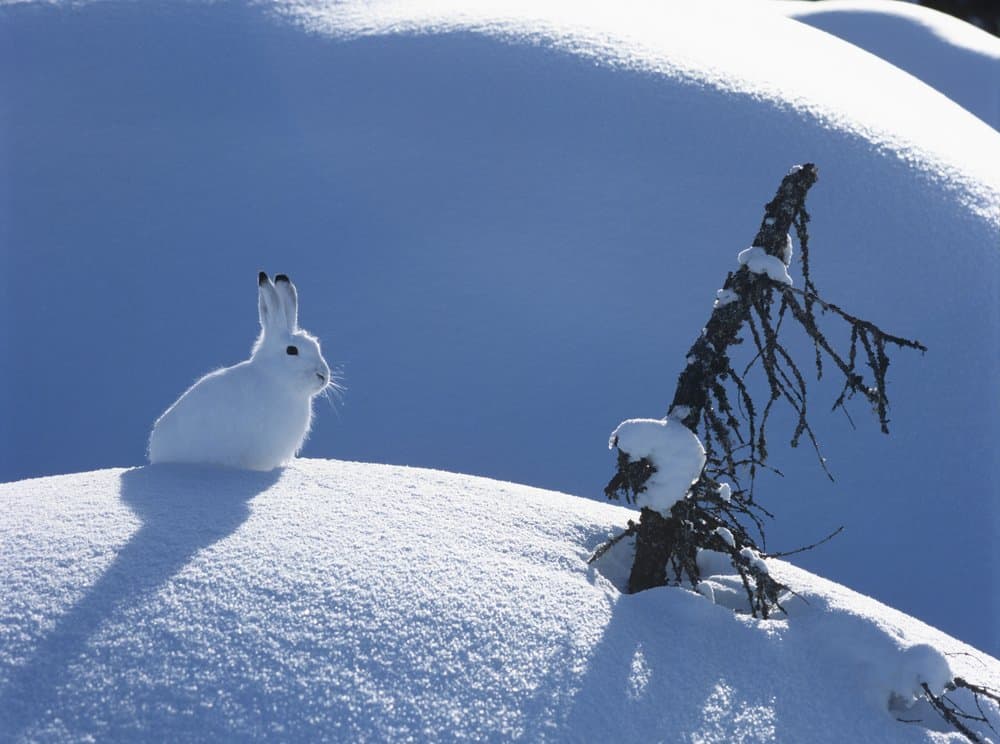
Its low metabolic rate allows it to easily conserve energy, a perfect trait for its barren environment.
©sirtravelalot/Shutterstock.com
The Arctic hare (Lepus arcticus) belongs to the hare family Leporidae. You can find Arctic hares in northern Greenland, Canada, and the Canadian Arctic islands. They can thrive in various habitats, including tundra, coasts, and plateaus, from sea level to elevations of 3,000 feet.
Like other hares, the Arctic hare is an herbivore whose diet consists primarily of leaves. However, unlike other hares, the Arctic hare evolved special adaptations to survive Arctic weather conditions. Its low metabolic rate allows it to easily conserve energy, a perfect trait for its barren environment. Meanwhile, the Arctic hare’s white fur insulates it from the cold. Additionally, its white coat reflects sunlight extremely well, which helps it avoid overheating during the day.
Numerous carnivores prey on Arctic hares, including snowy owls, Arctic foxes, and Arctic wolves. However, due to its widespread distribution and dense population, the IUCN lists the Arctic hare as a species of Least Concern.
6. Narwhal
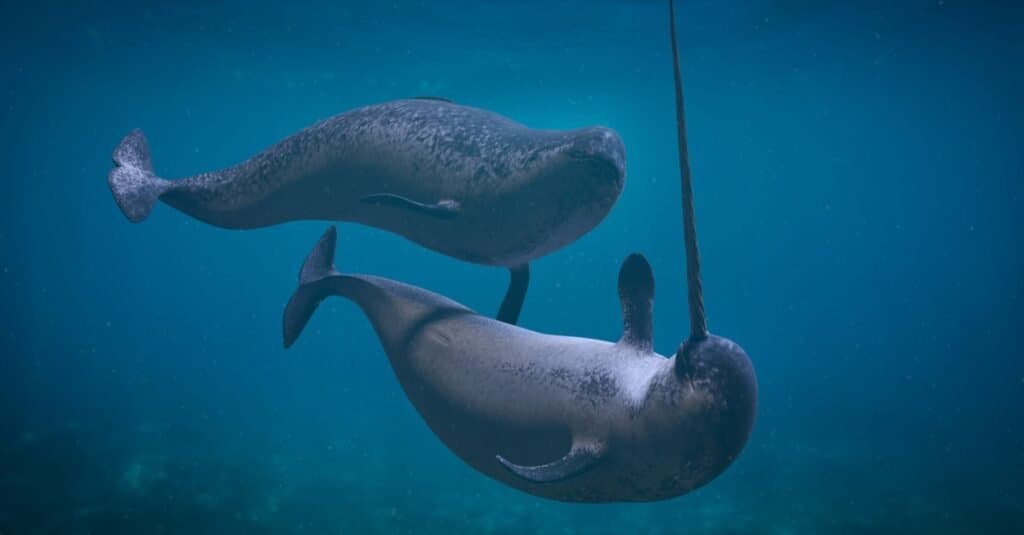
You can find narwhals year-round in the Arctic waters off Russia, Canada, and Greenland.
©iStock.com/dottedhippo
A close relative of the beluga whale, the narwhal (Monodon monoceros) is a toothed whale in the family Monodontidae. Its scientific name translates to “one-tooth one-horn,” in reference to the single large tusk sported by the males. You can find narwhals year-round in the Arctic waters off Russia, Canada, and Greenland.
Scientists classify narwhals as medium-sized whales. Adults vary between 13 and 18 feet long, with females measuring slightly smaller than males. On average, adults weigh between 1,760 and 3,530 pounds. Narwhals can survive in extremely cold water thanks to their thick layer of blubber. They can dive for up to 25 minutes to depths of 4,920 feet to find prey under heavy ice packs.
Narwhals exhibit complex social behaviors, including the formation of large pods during the summer months. They can live up to 50 years, with the primary causes of death including hunting, predation by polar bears or orcas, and suffocation when they are trapped under ice. The narwhal is listed as a species of Least Concern by the IUCN.
7. Reindeer

Unlike other deer species, both males and females grow antlers.
©Vladimir Melnikov/Shutterstock.com
Also known as caribou, reindeer (Rangifer tarandus) belong to the deer family Cervidae. They live in the Arctic tundra and sub-Arctic regions of Russia, Canada, Alaska, and northern Europe.
Unlike other deer species, both males and females grow antlers. They come in six different subspecies, with each subspecies differing in size and color. All reindeer feature two layers of dense fur that help to insulate them against the cold. Their large hooves enable them to walk on top of the snow, while their blood vessels efficiently circulate blood to retain heat.
Reindeer are herbivores and eat a high-carbohydrate diet rich in lichens and moss to help them survive harsh winters. While reindeer subspecies are quite numerous, others are rare or threatened. Still, overall, the IUCN classifies reindeer as a species of Least Concern.
8. Snow Leopard
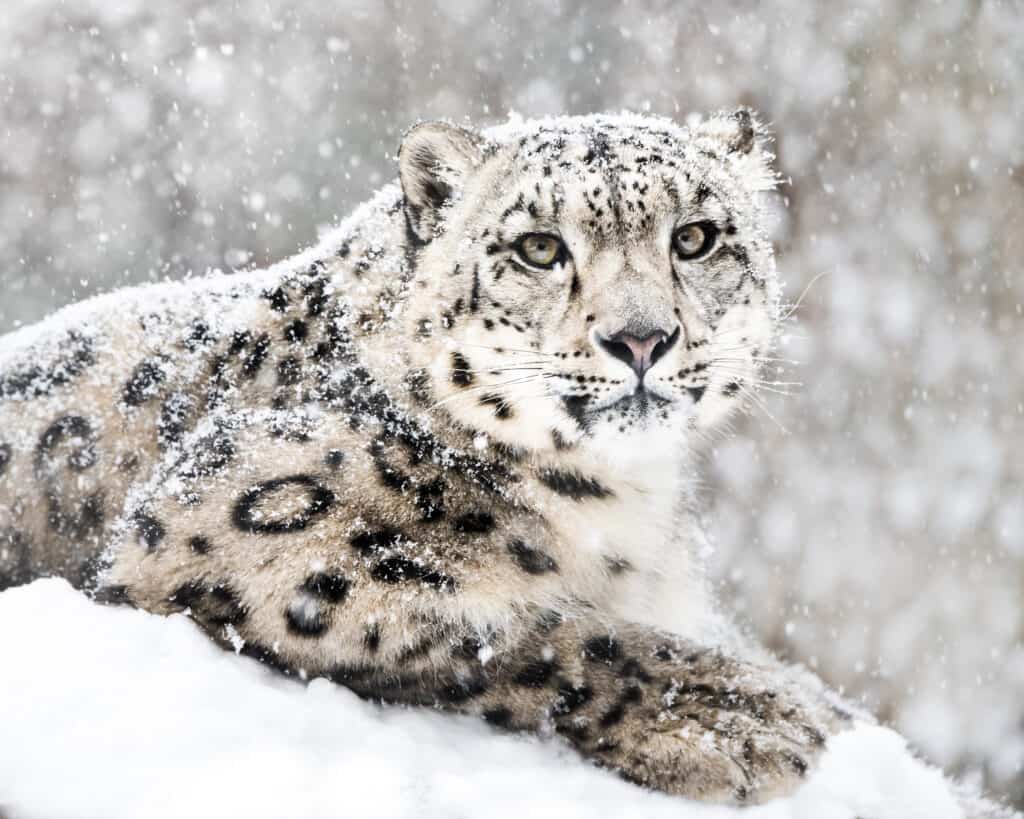
Interestingly, snow leopards store fat in their tail, which they use like a blanket to cover their face when asleep!
©Abeselom Zerit/Shutterstock.com
The snow leopard (Panthera uncia) belongs to the cat family Felidae. You can find this large cat at high altitudes in the Himalayas and other mountain ranges in Central Asia.
Snow leopards possess whitish-gray fur covered in dark spots and rosettes. Their fur is thick, measuring 2 to 4.7 inches long in most spots. Meanwhile, their small, round ears help them to retain heat, while their large paws make it easy to walk on the snow. Interestingly, snow leopards store fat in their tail, which they use like a blanket to cover their face when asleep!
The snow leopard is one of the most reclusive animals on the planet. Snow leopards live alone and spend most of their time hunting for mountain ungulates like Himalayan tahr, goats, and deer. The snow leopard ranks as one of the rarest big cats on Earth, with an estimated wild population of only 10,000. Unfortunately, snow leopards face numerous threats to their continued existence, including habitat loss, poaching, and climate change. Presently, the IUCN lists the snow leopard as an Endangered species.
9. Muskox
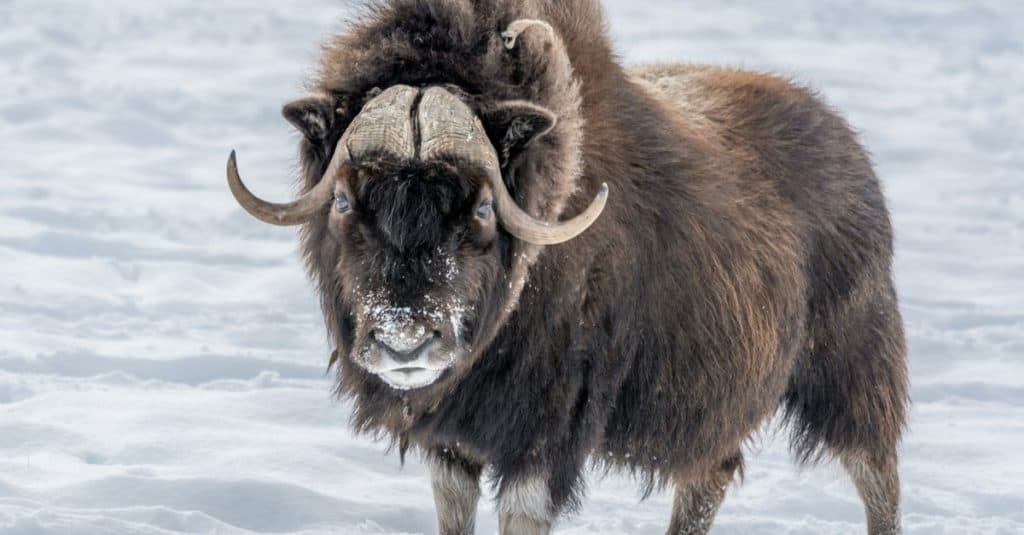
Muskox can thermoregulate their bodies, allowing them to shut off heat to certain parts to better retain heat in others.
©Fitawoman/Shutterstock.com
The muskox (Ovibos moschatus) is in the family Bovidae. It is native to the Arctic tundra and found in Greenland, Canada, Alaska, Russia, and parts of northern Europe.
Male and female muskox sport long, curved horns. They stand 4 to 5 feet tall, are 4.4 to 6.6 feet long, and weigh between 400 and 900 pounds. Their shaggy fur acts like a big blanket and helps to insulate them from the cold. Additionally, muskox can thermoregulate their bodies, allowing them to shut off heat to certain parts to better retain heat in others.
Muskox feed on a variety of plants and are known for aggressively defending their herds. In the 1900s, muskox populations plummeted due to overhunting. However, in the last few decades, many countries adopted strict hunting regulations to protect muskox. This allowed the species to slowly recover, and now the IUCN lists it as a species of Least Concern.
10. Emperor Penguin

Emperor penguins live in Antarctica, breeding during the winter in temperatures around -40 degrees Fahrenheit.
©Joey_Danuphol/Shutterstock.com
The last entry on our list resides in one of the coldest places on Earth. The emperor penguin (Aptenodytes forsteri) is the largest member of the penguin family, Spheniscidae. Both males and females stand around 39 inches tall and weigh between 49 and 99 pounds. They feature distinctive pale-yellow feathers on their breast, black feathers on the back and head, and white bellies.
Emperor penguins live and breed in Antarctica. Moreover, they breed during the winter in temperatures around -40 degrees Fahrenheit. Emperor penguins evolved several traits to help them survive such frigid conditions. Their dense feathers insulate them from the worst of the cold. A layer of fat 1.2 inches thick directly beneath their skin adds additional insulation. Additionally, penguins can maintain their core body temperature without having to alter their metabolism. When wind chills and temperatures drop to dangerous levels, emperor penguins huddle in large groups to stay warm. Each penguin takes a turn standing at the edge of the group where the temperature is coldest.
Emperor penguins feed on a variety of fish and krill and are known for their deep dives, which can reach depths of over 500 meters. While fishing, they must watch out for predators like orcas and leopard seals. Due to dwindling food supplies and habitat loss brought on by climate change, the IUCN lists the emperor penguin as a Near Threatened species.
Up Next:
The photo featured at the top of this post is © Tatyana Step/Shutterstock.com
Thank you for reading! Have some feedback for us? Contact the AZ Animals editorial team.






